The world is so much weirder than we think and its bodies of water can be included in this statement. Water is clear, or not. Oceans are turquoise or blue, or sometimes grey when angry. Rivers and lakes can vary from brown to green to blue but not red or pink unless coloured by a school child. Or is any of this true? There is so much more going on in the water than first thought. Bodies of water can be changed from the standard colours to the more exotic depending on their pH, bacteria and algae content, and their chemical and mineral makeup. In this blog we will tell you about a few of the more interesting ones and the reasons why and yes, there may be talk of environmental issues. Maybe you could add a few of these to your bucket list.
The Blue Lagoon, Iceland– This geothermal spa located in southwestern Iceland is rich with sulphur and silica that produces a beautiful 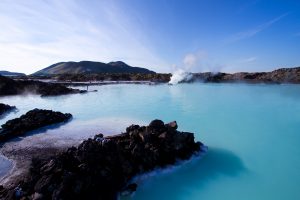 milky blue colour (hence the name). It is rumoured to be good for anyone suffering from skin disorders which makes it a huge tourist attraction. The minerals are pushed up to the surface from deep within the geological layers by hot water averaging between 37 and 39 degrees Celsius. Although there are many naturally occurring hot springs in Iceland, the Blue Lagoon is man-made. It is fed by the nearby geothermal plant located in a lava field and the water is renewed every two days.
milky blue colour (hence the name). It is rumoured to be good for anyone suffering from skin disorders which makes it a huge tourist attraction. The minerals are pushed up to the surface from deep within the geological layers by hot water averaging between 37 and 39 degrees Celsius. Although there are many naturally occurring hot springs in Iceland, the Blue Lagoon is man-made. It is fed by the nearby geothermal plant located in a lava field and the water is renewed every two days.
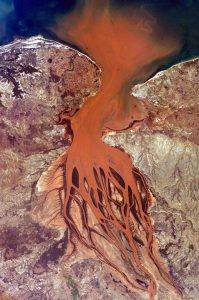
Belsiboka River, Madagascar- Belsiboka River runs 500+ kilometres in central Madagascar emptying into the Bombetoka Bay forming a large delta. The river carries so much reddish-brown silt that it looks as if the island is bleeding into the sea and is viewable from space (which the NASA photo here shows). This awesome site is an example of huge soil erosion inland caused by the deforestation for cultivation and pastureland. The soil losses here are some of the largest recorded anywhere in the world and proves to be one of the fastest changing coastlines.
Laguna Verde, Bolivia– Nestled between two volcanoes at an altitude of 4300 metres; Laguna Verde is a salt lake in Bolivia near the border with Chile. It is in an endorheic basin or closed basin (meaning that it has very limited drainage and has no outflow to another body of water). The water contains arsenic and other minerals which is the reason for the green colour which can range from turquoise to dark emerald depending on the disturbance of the sediments. Even in the coldest temperatures, Laguna Verde does not freeze due to the high mineral content. (Pictured at the top of the page.)
Lake Hillier, Australia– Who wouldn’t want see a bubblegum pink lake? This lake lies in Western Australia and stands in stark contrast to 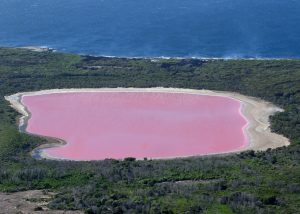 the surrounding green eucalyptus forest and blue Pacific Ocean next to it. The reason of its truly striking colour is not fully understood but scientists think that it has to do with the presence of Dunaliella salina microalgae that produce carotenoids (a pigment found in carrots) but this is not the only theory. It may be the presence of halophilic bacteria in the salt crust or a reaction between the salt and the sodium bicarbonate. Whatever may cause it, it has become a tourist attraction although it is hard to get to and people normally only view it from an airplane.
the surrounding green eucalyptus forest and blue Pacific Ocean next to it. The reason of its truly striking colour is not fully understood but scientists think that it has to do with the presence of Dunaliella salina microalgae that produce carotenoids (a pigment found in carrots) but this is not the only theory. It may be the presence of halophilic bacteria in the salt crust or a reaction between the salt and the sodium bicarbonate. Whatever may cause it, it has become a tourist attraction although it is hard to get to and people normally only view it from an airplane.
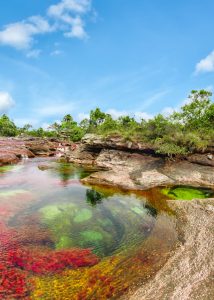 Caῆo Cristales, Colombia– “The River of Five Colours” located in Vista Hermosa, Colombia is definitely one of the most beautiful rivers in the world. For most of the year it is a regular river of clear water with a visible rocky bottom and green mosses but for a short period of time between the wet and dry seasons, it blooms into brilliant colours. This is caused when of a unique species of plant, Macarenia clavigera, turns bright colours from yellow to green to blue to its dominant colour of bright red. The water itself is so clear because the lack of nutrients and particles (which is different from the majority of our examples). Travel to the river had been closed due to guerrilla activity in the area but now tours can be arranged.
Caῆo Cristales, Colombia– “The River of Five Colours” located in Vista Hermosa, Colombia is definitely one of the most beautiful rivers in the world. For most of the year it is a regular river of clear water with a visible rocky bottom and green mosses but for a short period of time between the wet and dry seasons, it blooms into brilliant colours. This is caused when of a unique species of plant, Macarenia clavigera, turns bright colours from yellow to green to blue to its dominant colour of bright red. The water itself is so clear because the lack of nutrients and particles (which is different from the majority of our examples). Travel to the river had been closed due to guerrilla activity in the area but now tours can be arranged.
Grand Prismatic Spring, Wyoming– This spring is the largest hot spring in the United States and the third largest in the world located at 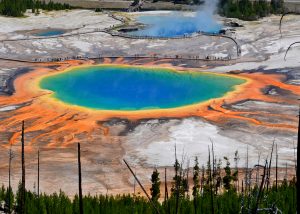 Midway Geyser Basin in Yellowstone National Park. It received its name because of the vibrant colours of the optical prism; red, orange, yellow, green, and blue. This is caused by the microbial mats (a multi-layered sheet of microorganisms such as bacteria and archaea) around the edges of the mineral-rich water. The colours are dependent on the ratio of chlorophyll to carotenoids (we talked of these guys before with Lake Hillier) and on the difference of temperature from the centre to the edges. The centre is a dark blue due to the depth of over 36 metres and the intense heat that causes sterility. Researchers have been studying it for decades to try and help them understand how life on this planet evolved and how it might exist on other planets.
Midway Geyser Basin in Yellowstone National Park. It received its name because of the vibrant colours of the optical prism; red, orange, yellow, green, and blue. This is caused by the microbial mats (a multi-layered sheet of microorganisms such as bacteria and archaea) around the edges of the mineral-rich water. The colours are dependent on the ratio of chlorophyll to carotenoids (we talked of these guys before with Lake Hillier) and on the difference of temperature from the centre to the edges. The centre is a dark blue due to the depth of over 36 metres and the intense heat that causes sterility. Researchers have been studying it for decades to try and help them understand how life on this planet evolved and how it might exist on other planets.
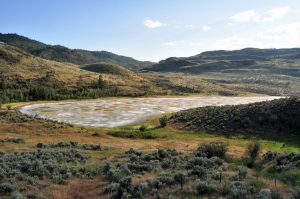 And closer to home, we have Spotted Lake, BC– A small lake that is rich in minerals including calcium, sodium sulphates, and magnesium sulphate that lies in southern British Columbia, not far from Osooyos. Anyone who has visited this area knows of the hot summers and in this heat much of the lake evaporates leaving concentrations of these minerals that form spots that are visible in the lake. The spots can change shape and size during the summer and the colours can range from blue to green to yellow. This lake has been a sacred place for the First Nations people of this area and is protected from development. If you want to see it, please be respectful of the cultural significance to the Okanagan Nation and view it from behind the fence.
And closer to home, we have Spotted Lake, BC– A small lake that is rich in minerals including calcium, sodium sulphates, and magnesium sulphate that lies in southern British Columbia, not far from Osooyos. Anyone who has visited this area knows of the hot summers and in this heat much of the lake evaporates leaving concentrations of these minerals that form spots that are visible in the lake. The spots can change shape and size during the summer and the colours can range from blue to green to yellow. This lake has been a sacred place for the First Nations people of this area and is protected from development. If you want to see it, please be respectful of the cultural significance to the Okanagan Nation and view it from behind the fence.
There you have it: weird bodies of water and the reasons why. I feel as if this has been a bit of a travelogue with a science-y bent. I wouldn’t mind seeing a few of these for myself.
–Janice Willson
Photo Sources: Blue Lagoon, Frank Denny; Belsiboka River, NASA; Laguna Verde, Ville Mietlinen; Lake Hiller, Aussie OC; Caῆo Cristales, Mario Cervajal; Grand Prismatic Spring, Clement Bardot; Spotted Lake, Mykola Swarnyk

